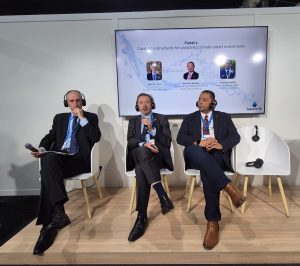This week at COP29, we hosted the session “Catalysing Private Investments in Water and Sanitation with Climate Impact,” bringing together global leaders and innovators to explore how blended finance can unlock private investments in water and sanitation, crucial for achieving SDG 6. The discussion highlighted the importance of de-risking instruments, insurance, public and philanthropic funds, and government involvement in enabling transformative, climate-smart solutions for the sector.
Water is central to climate change, biodiversity loss, food and energy crises, and poverty. Investing in water offers multiple co-benefits, making it a priority for sustainable development. Climate change further exacerbates water challenges, requiring significant annual investments to meet SDG 6.
Takeaways
Tackling the finance gap: Overcoming long-term investment hurdles
The water and sanitation sector face an immense funding challenge, one too large for government budgets, donor contributions, or even the world’s largest multilateral institutions to handle alone. Achieving SDG 6 will require innovative and collaborative solutions to close this significant financing gap.
A key barrier to investments is the mismatch between the sector’s funding needs and investors’ expectations. Private equity investors, typically focused on quicker returns, often shy away due to the extended timeframes required in water and sanitation projects. This highlights the critical need for institutions with a patient, long-term outlook willing to take on these investments.
Moreover, returns in the water sector are generally lower than those in other industries. This makes it vital for long-term investors to embrace a balanced approach, weighing lower financial returns against the broader developmental impact. By fostering partnerships that value sustainable growth and societal benefits, we can ensure progress in addressing global water and sanitation challenges. The road ahead requires not just financial resources but also a shift in perspective.
The role of blended finance
Blended finance has emerged as a game-changer, driving private investment into water and sanitation enterprises in developing countries over the past five years. By merging public and private funding, it creates innovative solutions to tackle water scarcity, improve sanitation, and boost climate resilience—making additional private and institutional funding critical for lasting impact. Blended finance catalyses private investment and enhances its efficiency, effectiveness, and developmental impact.
To attract global capital and secondary investors, scaling investments is crucial. The European Investment Bank (EIB) exemplifies this approach, partnering with governments, donors, and private investors to drive water projects. As one of the largest multilateral lenders in the sector, the EIB invests approximately €3 billion annually (2019–2023), with water making up over 30% of its non-EU activities —a testament to its strategic focus on global water solutions. Blending concessional funding with other financing mechanisms is crucial for high-impact investments in developing and fragile countries.
Catalytic instruments, funding and insurance
Private sector engagement is key to funding climate adaptation and achieving Nationally Determined Contributions (NDCs). In the MENA region alone, $600 billion is needed, but despite $46 trillion in regional bank assets, investment lags due to uncertainties in revenue and financial viability. Catalytic instruments, funding, and insurance can bridge this gap, unlocking the potential for impactful investments.
While climate finance drives investment by de-risking upfront costs, insurance is the enabler that ensures these investments succeed—especially in water and sanitation. The gap between funds and investable projects often stems from poor risk management. To bridge this, insurance must shift to long-term models, supported by blended finance and concessional frameworks. Public-private collaboration in insurance can unlock investment in emerging markets, where commercial options are scarce, catalysing transformative climate solutions.
High upfront costs, under-pricing, and sustainability challenges hinder investment in developing regions. The Green Climate Fund (GCF) tackles these barriers by leveraging its risk-taking capacity to attract private investors while ensuring affordability and access. Successful initiatives in South Africa showcase a model for scaling solutions to other regions.
While bankability is key to attracting investment, affordability and inclusivity, including gender considerations, must be maintained, alongside the use of blended finance and technical assistance for long-term success.
Dual goals: Impact and profitability
Investments in water funds and local banks prove that water projects can deliver financial returns, climate resilience, and positive social outcomes. With tools like de-risking, technical assistance, results-based financing, and philanthropic funding, the gap between impact-focused and commercial investors is narrowing, unlocking the sector’s full potential.
The Water Access Acceleration Fund (W2AF) has mobilised $62 million from investors, including wealthy families, corporations, and banks. Its latest investment in Spouts International in Uganda showcases the power of innovative business models, providing affordable ceramic water filters and leveraging carbon credits to improve access to clean water for 700,000 people while reducing the environmental impact of boiling water with charcoal or firewood.
The “Under One Roof” approach by WaterEquity, Water.org, and Water Connect creates a seamless pipeline from capital generation to project execution. By combining philanthropic funding, private investment, and technical expertise, this model drives scalable, impactful solutions.
Similarly, Aqua for All tailors blended finance models—such as water funds and loan portfolios—to meet the unique needs of different regions. Partnerships with Kenyan banks, like Cooperative Bank, have made financing for utility infrastructure possible, transforming perceptions of what’s achievable. These initiatives also empower small-scale water projects, ensuring they are both bankable and scalable.
Rising corporate interest in water investments
Historically, water investments lagged behind climate mitigation, but that’s changing. Companies are increasingly aware that the greatest water-related risks lie beyond their operations, in the broader watershed. This shift is driving more investments in community initiatives and nature-based solutions.
Corporates now recognise that philanthropy and operational spending alone won’t close the water sector’s vast finance gap. Many are turning to balance sheet investments to meet water stewardship and sanitation goals.
The Water Resilience Coalition, led by the CEO Water Mandate, brings together nearly 40 companies with a combined market cap of $4 trillion. Their goal is to improve water resilience in 100 water-stressed basins and provide climate-resilient water and sanitation to 350 million people by 2030. Companies are prioritising regions tied to their operations, supply chains, or key markets, focusing on water quantity, quality, and equitable access.
Collaborative investments, like those with Aqua for All and WaterEquity, are targeting water-stressed areas to stabilise supplies while benefiting communities and the environment. New accounting frameworks are also helping companies align water investments with broader goals—such as health, nature conservation, and economic resilience—strengthening the business case for these investments.
By recognising co-benefits and fostering collaboration, corporates are making larger, more impactful water investments—critical for addressing climate challenges and improving conditions in high-risk basins worldwide.
Public-private collaboration: Key to unlocking water, sanitation and climate financing
Strategic government involvement is crucial to incentivise private sector participation and ensure stability, especially in times of crises. Governments must engage early in decision-making to act as “shock absorbers” through public funding to de-risk investments and make the water and sanitation sector more attractive.
Effective coordination between governments and private sector players is key to aligning policies, creating enabling environments, and encouraging investment and bridging the gap between private investment and government support through policy dialogue.
For instance, Uganda is adopting a “whole-of-society” approach, engaging private investors in market-based solutions like affordable water and sanitation services, such as low-cost toilets, and training local labour.
Government backing is essential to de-risk investments and ensure their long-term sustainability. Integrating private sector contributions into public policy and financing frameworks is vital to catalyse further investment.
Addressing funding gaps in the water sector requires long-term strategies and robust regulatory frameworks. Inconsistent regulations across regions can deter private investment, making stable, well-defined frameworks crucial. For instance, the EIB is providing technical assistance to develop consistent, effective regulations, which are critical to attracting investment in the water sector.

Conclusion
Achieving SDG 6 by 2030 requires urgent action, including innovative financial strategies and multi-stakeholder partnerships to drive change and ensure universal access to water and sanitation. Blended finance solutions and aligning investments with sustainable, climate-resilient goals are key to making lasting progress.
While advancements have been made, scaling these initiatives demands ongoing effort, diversified solutions, and continued collaboration between the public, private, and philanthropic sectors. Our side event emphasized that while progress has been made, scaling these initiatives requires sustained effort, diverse solutions, and ongoing collaboration across the public, private, and philanthropic sectors.
We extend our sincere thanks to all the speakers and panellists who shared their expertise and insights during the session. Their contributions have deepened our understanding of the solutions needed to tackle water and climate challenges and accelerate progress in the water and sanitation sector. A special thank you to Amgad Elmahdi, Andrea Clerici, Anthony Hobley, Gary White, Herbert Nabaasa, Jason Morrison, Paul Buysens, and Wampie Libon for their time, commitment, and leadership. We look forward to continued collaboration in the years ahead.
For more insights, watch the session here.



